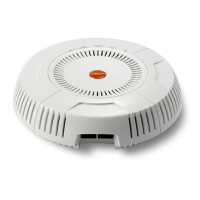Wireless Access Point
Configuring the Wireless AP 315
6. Set Channel Lock to Block auto-channel assignment if you want to lock
in your channel selection so that an autochannel operation (see Advanced
RF Settings) can’t change it. A locked padlock will be displayed for
the IAP.
7. The Bond field works together with the Channel selected above. (For
802.11n IAPs, it also obeys the bonding options selected on the Global
Settings .11n page.) Also see the discussion in “80 MHz and 160 MHz
Channel Widths (Bonding)” on page 48. Bonding is available on all APs,
including two-radio models. For 802.11n, two 20MHz channels may be
bonded to create one 40 MHz channel with double the data rate. 802.11ac
offers an additional option to bond four 20MHz channels to create one
80MHz channel with four times the data rate.
• Channel number — If a channel number appears, then this channel is
already bonded to the listed channel.
• Off — Do not bond his channel to another channel.
• 40 MHz — Bond this channel to an adjacent channel. The bonded
channel is selected automatically by the AP based on the
Channel (Step 5). The choice of banded channel is static — fixed once
the selection is made.
• 80 MHz — Bond this channel to three adjacent channels. The bonded
channels are selected automatically by the AP based on the
Channel (Step 5). The choice of bonded channels is static — fixed once
the selection is made.
The top line for the IAP will show the channels that have been assigned
based on the width of the bond.
As mandated by FCC/IC law, APs continually scan for signatures of radar.
If such a signature is detected, the AP will switch operation from conflicting
channels to new ones. The AP will switch back to the original channel after
30 minutes if the channel is clear. If a radio was turned off because there were
no available channels not affected by radar, the AP will now bring that radio
back up after 30 minutes if that channel is clear. The 30 minute time frame
complies with FCC/IC regulations.

